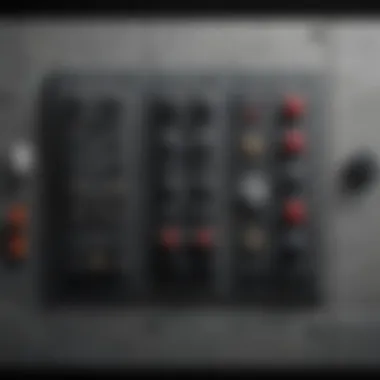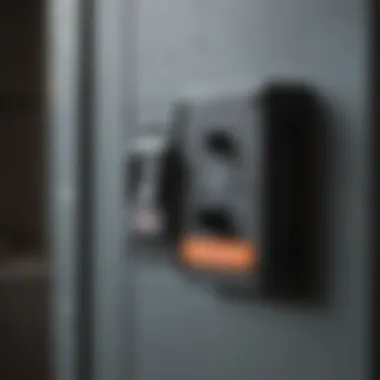How to Fix a Blown Circuit Breaker: A Complete Guide


Intro
A blown circuit breaker can leave homeowners feeling frustrated and confused. Understanding how to address this common electrical issue is essential for maintaining a safe and functional home environment. In this guide, we will cover the signs that indicate a circuit breaker has blown, the tools you need for repair, and step-by-step instructions to fix the problem safely. We will also discuss important safety precautions and circumstances when calling a professional is advisable.
Signs of a Blown Circuit Breaker
Recognizing the symptoms of a blown circuit breaker is the first step in tackling this issue. Common signs include:
- Power loss: One or more outlets or lights are not working.
- Tripped breaker: The switch on the breaker panel is in the position.
- Burning smell: An unusual odor near the circuit panel can indicate a problem.
- Flickering lights: Lights that flicker frequently may signal an underlying issue.
Identifying these signs quickly can prevent further damage to your electrical system.
Tools Required for Fixing a Blown Circuit Breaker
Before you start repairing a blown circuit breaker, gather the following tools:
- Screwdriver: A flathead or Phillips screwdriver for removing the panel cover.
- Voltage tester: Ensure proper power status before working on any electrical components.
- Replacement circuit breaker: Have a compatible circuit breaker on hand if needed.
Having these tools ready will streamline the process and ensure safety.
Step-by-Step Instructions
Follow these steps to fix a blown circuit breaker:
- Turn Off Main Power: Before working on the breaker box, turn off the main power switch to ensure safety.
- Locate the Panel: Find your circuit breaker panel, often situated in a garage, basement, or utility room.
- Open the Panel Cover: Use the screwdriver to carefully remove the panel cover.
- Check for Issues: Look for any visible damage or burning, particularly around the affected circuit.
- Reset the Circuit Breaker: Flip the tripped breaker fully to the off position and then back to the on position. If it stays on, you may have resolved the issue.
- Replace the Breaker: If the breaker continues to trip, it may need replacement. Unscrew the faulty breaker from the panel and disconnect it. Connect the new breaker and secure it.
- Test the System: Once everything is reassembled, turn the main power back on and test the circuit.
Safety Precautions
Safety cannot be overlooked when dealing with electrical issues. Here are vital precautions:
- Always work with the main power off.
- Use insulated tools to minimize electrical shock risks.
- If you're uncertain about the situation, do not hesitate to call a professional electrician.
Always prioritize safety when dealing with electrical repairs.
When to Seek Professional Help
If you try to fix the blown breaker without success, or if you notice continual tripping, it’s crucial to consult a qualified electrician. Problems could range from serious wiring issues to outdated systems that need upgrades.
By gaining knowledge and understanding of how to manage a blown circuit breaker, you empower yourself to become more self-sufficient in maintaining your home’s electrical system.
Understanding Circuit Breakers
Understanding circuit breakers is crucial for any homeowner. They serve as fundamental components of residential electrical systems. Without a clear grasp of their functions and types, addressing electrical issues may become daunting. Circuit breakers protect your home from electrical overloads, faults, and fires. Knowing how they work can empower you to maintain and troubleshoot your electrical system effectively.
A circuit breaker acts like a safety switch. It automatically interrupts the flow of electricity when it detects a problem. This is an essential feature for avoiding dangerous situations such as electrical fires or equipment damage.
In this guide, we will explore various aspects of circuit breakers, including their definitions, types, and operations. Gaining insight into these areas is valuable for averting future electrical hazards and ensuring safety.
What is a Circuit Breaker?
A circuit breaker is an electrical device designed to stop the flow of electricity in a circuit when it detects a fault or overload. It plays a protective role in your electrical system by automatically switching off the power when necessary, thus preventing potential damage to appliances or wiring. Unlike fuses, which need replacement after they blow, circuit breakers can be easily reset and reused, making them more user-friendly and efficient.
Types of Circuit Breakers


Several types of circuit breakers exist, each with unique characteristics and applications. Understanding these can help you select the right breaker for your home.
Standard Breakers
Standard breakers, also known as thermal-magnetic breakers, are commonly used for residential applications. They combine both thermal and magnetic protection. The thermal aspect reacts to heat, protecting against overloads, while the magnetic aspect responds to sudden surges. Due to their simplicity and effectiveness, standard breakers are a popular choice for home electrical systems. They are reliable but can trip under high load conditions, requiring resetting.
GFCI Breakers
Ground Fault Circuit Interrupter (GFCI) breakers add an additional layer of safety by monitoring the electrical flow in a circuit. They are especially important in areas with potential water exposure, such as kitchens and bathrooms. If the GFCI detects a ground fault, it rapidly shuts off electricity, preventing electric shock. Their key characteristic of quick disconnect makes them highly beneficial for safety-focused environments. However, they may trip more frequently than standard breakers, requiring more attention.
AFCI Breakers
Arc Fault Circuit Interrupters (AFCI) breakers are designed to protect against arc faults, which may occur due to damaged or frayed wiring. They distinguish between normal and hazardous conditions, disrupting power to avoid electrical fires. AFCI breaks are increasingly required in modern homes, making them a vital choice for ensuring electrical safety. The downside is that they can be sensitive, leading to unwanted trips in certain cases.
How Circuit Breakers Work
Circuit breakers work by sensing electrical anomalies within a given circuit. When normal functioning is compromised, such as during an overload or short circuit, the breaker interrupts the flow of current. This interruption occurs through a mechanical mechanism that moves away from the electrical contact points. The design enables users to reset the circuit once the issue is resolved. Understanding this working principle is vital for homeowners dealing with blown circuit breakers.
Identifying a Blown Circuit Breaker
Identifying a blown circuit breaker is a crucial part of maintaining your electrical system at home. This section delves into how to spot the signs of a blown circuit breaker and the actions you should take. Knowing these indicators allows for timely intervention, which can prevent further electrical issues or potential hazards. Recognizing a malfunction early can save you time and money in the long run.
Symptoms of a Blown Breaker
Loss of Power
Loss of power is often the most noticeable symptom when a breaker blows. When a circuit breaker fails, the electrical current stops flowing to the affected area, resulting in lights and outlets ceasing to function. This immediate disruption serves as a clear indicator that something has gone wrong. The simplicity of this symptom makes it a beneficial choice for identifying issues quickly. However, it’s important to be aware that loss of power may also indicate other problems unrelated to the breaker itself. Checking the breaker box should be your first step when you experience this issue.
Burning Smell
A burning smell is a more serious indicator that there may be a problem with your circuit breaker. If you notice a hot, acrid scent around your breaker, this might suggest overheating or even the beginning stages of an electrical fire. This symptom highlights a crucial safety concern and should not be ignored. The urgency of addressing a burning smell is significant due to its potential to escalate into a fire hazard. In such cases, it may be wise to immediately cut off power and contact a professional.
Discoloration of Breaker Box
Discoloration of the breaker box often points to overheating or electrical faults in the system. This can manifest as brown, black, or other dark spots around the breakers. The cumulative effect of heat can damage the electrical components, further undermining their functionality. This symptom is particularly important because it not only indicates a blown breaker but also highlights potential deterioration of your electrical system. Ignoring discoloration could lead to increased risks and potentially costly repairs in the future.
Visual Inspection of Circuit Breaker
A visual inspection of the circuit breaker is essential in diagnosing the issue effectively. Look for any obvious signs of damage, such as cracks in the plastic or the presence of scorch marks. Signs of wear can indicate that the breaker is no longer functioning as intended. Ensure that the breaker lever is in the 'off' position, which can indicate that it has tripped. Many circuit breakers also have a reset button that may provide further insight into their operational status.
Before conducting any inspections, always prioritize your safety. Wear protective gear and make sure the power is turned off at the main service panel. Regular inspection of your circuit breakers can help identify issues before they escalate, ensuring your electrical system remains reliable.
Tools and Materials Needed
Knowing the right tools and materials is important for fixing a blown circuit breaker. Using proper tools can make the process safer and more efficient. Each tool plays a specific role in the troubleshooting process. Selecting the correct equipment is crucial for successfully addressing electrical issues. Here are essential tools and safety gear to consider prior to starting your task.
Essential Tools
Screwdriver
The screwdriver is a fundamental tool needed for any electrical repairs. Its main purpose is to remove screws from the circuit breaker box. A flat-head or Phillips screwdriver is typically necessary, depending on the screws. A screwdriver with an insulated handle is often recommended. This feature provides an extra layer of safety by reducing the risk of electric shock during repairs. Many people find screwdrivers to be an essential component of their toolkits. Their simplicity and immediate accessibility contribute to their popularity.
Voltage Tester


The voltage tester is vital for ensuring safety while working on electrical systems. Before handling any electrical components, checking for an active current is necessary. One key characteristic of a voltage tester is its ability to indicate if power is present without direct contact. This non-contact testing minimizes risk during inspection. For this reason, many consider voltage testers a beneficial tool when dealing with electrical problems. Their effectiveness makes them popular among DIY enthusiasts and professionals alike.
Flashlight
Having a reliable flashlight on hand is often overlooked but equally important. Many circuit breaker boxes are located in dark or cramped spaces. A good flashlight allows for clear visibility when investigating a blown circuit. Choosing one that is bright and easy to carry can enhance the working experience. Whether it runs on batteries or is rechargeable, a dependable flashlight ensures safety and efficiency during repairs. Thus, it is wise to consider having this tool in your equipment.
Safety Equipment
Safety equipment is crucial when working with electrical systems. Using appropriate personal protective gear is necessary to prevent injuries. Investing in safety equipment shows due diligence towards your well-being during repair work.
Safety Gloves
Safety gloves provide necessary hand protection when working with electrical components. They can prevent cuts, abrasions, or electrical shocks. The key characteristic of safety gloves is their insulation properties. Gloves made from rubber or other insulating materials are often recommended. Such gloves are a beneficial choice because they create a barrier between the skin and live wires. However, it is essential to ensure that they fit well and are not damaged before use.
Safety Goggles
Safety goggles are necessary for protecting the eyes from debris or accidental sparks. A key characteristic of quality goggles is a snug fit that prevents any particles from entering. Using goggles is a wise choice because they safeguard against unforeseen hazards when working with tools. This protection adds an extra layer of caution in electrical repairs. However, it is essential to select goggles that meet the appropriate safety standards for maximum effectiveness.
Step-by-Step Guide to Fixing a Blown Circuit Breaker
Fixing a blown circuit breaker is a crucial skill for homeowners. Understanding how to correctly approach this problem can save you time and money. Additionally, it enhances safety by reducing the risk of electrical hazards. This step-by-step guide aims to demystify the process and empower you with the knowledge necessary to restore power safely.
Shutting Off Power
Before you start any work, it is vital to turn off the power. This isn’t just a precaution; it’s a necessity to ensure safety. Usually, the main power switch is located in your breaker panel. Turn it off fully to cut the electrical supply to your home. By doing so, you prevent possible shocks or accidents while you assess the breaker.
Locating the Blown Circuit Breaker
Once power is off, the next step is to find the blown breaker. Open the breaker panel. You might find labels indicating what each breaker controls, which can help pinpoint the right one. Look for the breaker that is in the 'off' position or one that appears tripped. Sometimes, a visual inspection can reveal if a breaker is burned or damaged.
Resetting the Circuit Breaker
After locating the affected breaker, it’s time to reset it. To do this, push the breaker switch all the way to the 'off' position and then back to the 'on' position. You should feel a click when it resets. If it stays in the 'on' position, power has been restored successfully. However, if it trips again immediately, further investigation is needed.
Checking for Underlying Issues
Identifying whether there are underlying problems is essential. If the circuit keeps blowing, something is wrong. Here are two common issues:
Overloaded Circuits
Overloaded circuits occur when the electrical demand exceeds the capacity of the circuit. This can happen when too many devices are connected or when high-wattage appliances are used on a single circuit. The key characteristic of an overloaded circuit is that you may hear a buzzing sound or notice a dimming of lights before the breaker trips. Addressing overloaded circuits is beneficial because it prevents future issues and keeps your appliances and wiring safe from extremes.
Faulty Devices
Faulty devices can also trip a circuit breaker. Devices might have short circuits or internal faults, causing them to draw excessive current. It's crucial to unplug devices one by one to identify the faulty one. The unique feature of dealing with faulty devices is that fixing or replacing them can often resolve your issue without needing extensive rewiring or alterations. However, faulty devices can sometimes mask deeper electrical issues. Therefore, careful testing is necessary.
In summary, fixing a blown circuit breaker involves straightforward steps: turning off power, locating the breaker, resetting it, and checking for underlying issues. Each step reinforces safety and reliability. Taking the time to understand these problems helps in maintaining a stable home electrical system.
Safety Precautions
When addressing a blown circuit breaker, it is imperative to prioritize safety precautions. Electrical work carries inherent risks, and neglecting proper measures can lead to severe injury or even fatality. Homeowners should grasp the reality of these dangers and understand how to mitigate them effectively.
Electrical hazards can arise from various sources, such as exposed wires, faulty equipment, and improper handling of tools. Even seemingly minor mistakes can have significant consequences. Ensuring a safe environment while working on electrical systems is non-negotiable. To avoid accidents, one must commit to thorough preparation and attentiveness during the process.


The following sections detail specific measures to avoid electrical hazards and underscores the importance of using appropriate personal protective equipment.
Avoiding Electrical Hazards
To minimize the risk of electrical hazards while fixing a blown circuit breaker, individuals should adhere to these recommendations:
- Always Disconnect Power: Before initiating any troubleshooting, ensure the main power supply is turned off. This step prevents electric shock and equipment damage.
- Inspect Work Area: Clear any clutter and ensure the workspace is dry. Water and electricity can create dangerous conditions.
- Check Tools and Equipment: Inspect tools like voltage testers for wear or damage. Using defective tools increases the risk of accidents.
- Know Emergency Procedures: Familiarize yourself with how to respond in case of an electrical accident. Knowing how to shut off power quickly can save lives.
By maintaining a cautious mindset and following protocols, one can efficiently reduce risk factors associated with electrical work.
Using Proper Personal Protective Equipment
Utilizing personal protective equipment (PPE) is an essential aspect of ensuring safety when dealing with electrical systems. PPE serves as a barrier protecting against potential hazards. The following items should be considered:
- Safety Gloves: Insulated gloves are crucial. They protect against electric shock and prevent contact with live wires.
- Safety Goggles: Protect your eyes from flying debris, especially when working in confined spaces or using tools that can generate fragments.
- Non-Conductive Footwear: Wearing shoes designed to resist electricity can prevent shock hazards from ground faults or accidental contact.
Incorporating these protective measures into your approach goes a long way in safeguarding not just the individual but also the working environment. Ensuring that you are well-equipped minimizes the risk of accidents significantly.
"Safety is a continuous process of making sure that you are aware of your environment and the risks that accompany it."
In summary, the necessity of safety precautions cannot be overstated. They are the backbone of any electrical work, especially when troubleshooting issues like a blown circuit breaker. By taking proactive steps, an individual can protect themselves and maintain a secure environment.
When to Call a Professional
Understanding when it is appropriate to call a professional for electrical issues is essential. While some homeowners may feel confident addressing minor problems, certain situations require expert intervention to ensure safety and compliance with electrical codes. Attempting to fix complex issues without the necessary training can lead to more severe problems, including hazards like electrical fires.
Calling a professional not only mitigates risks but also ensures that work is completed correctly. Licensed electricians bring expertise and experience that is often lacking among DIY enthusiasts. They can quickly diagnose issues that may appear straightforward at first glance.
Signs You Need Expert Assistance
Several indicators can suggest that it’s time to call a professional. Here are some common signs:
- Frequent Tripping of Breakers: If a circuit breaker trips often, it may signify an overloaded circuit or a short circuit that needs further investigation.
- Burning Smell or Smoke: Any burning odors or visible smoke from outlets or the breaker panel are critical reasons to seek immediate help.
- Discolored Outlets or Switches: If you notice discoloration or charring around outlets or switches, this can indicate overheating and demands professional attention.
- Electrical Shocks: Experiencing mild electric shocks when touching appliances or outlets is a clear signal that you should involve a professional.
Always prioritize safety. If you are unsure about how to proceed, it is better to err on the side of caution and consult an electrician.
Understanding Complex Electrical Problems
Some electrical issues can be intricate and may not have simple solutions. Understanding when a problem is too complex for a homeowner involves recognizing the following scenarios:
- Wiring Issues: Old or faulty wiring can create numerous complications, including grounding issues or short circuits. A professional can replace or upgrade wiring to meet current standards.
- Electrical Panels: Problems with the main electrical panel, such as issues with circuit breakers or fuses, require expertise. An electrician can determine if an upgrade or replacement of the panel is necessary.
- Air Conditioner and Heater Systems: If these systems are causing electrical problems, a knowledgeable technician should inspect the connections and ensure proper function.
- Lighting Problems: Flickering lights may seem harmless, but they can point to serious wiring or overloading problems that an electrician should address.
Being aware of these complex scenarios can prevent safety hazards and ensure your home’s electrical system runs smoothly. In short, recognizing the limits of your skills and the complexity of problems is an important part of responsible homeownership.
Culmination
In this article, we have explored the essential components of addressing a blown circuit breaker. Understanding and fixing a blown circuit breaker is not just a matter of convenience; it is a fundamental skill for every homeowner. Safety, knowledge, and preparedness are key. Through this comprehensive guide, readers have gained insight into the entire process from identification to resolution.
Recap of Key Points
To summarize:
- Understanding the Circuit Breakers: Recognizing the types, their functions, and how they work is crucial.
- Identifying a Blown Circuit Breaker: Knowing the symptoms helps in quick diagnosis. Look for loss of power and burning smells.
- Tools and Materials: Familiarity with necessary tools like screwdrivers and safety equipment is essential for any electrical task.
- Step-by-Step Guide: The correct process to reset and check for underlying issues can save both time and money.
- Safety Precautions: Always prioritize safety to prevent accidents and ensure a secure working environment.
- When to Call a Professional: Recognizing the limits of your expertise is important for dealing with complex issues.
Empowering Homeowners with Knowledge
Empowering homeowners involves more than just providing information. It is about instilling confidence in managing common electrical problems. Knowledge about circuit breakers aids in making informed decisions. This understanding can minimize risks associated with basic electrical issues. Homeowners should not feel intimidated by the prospect of fixing a blown circuit breaker. Instead, they should view it as an opportunity to enhance their skills and safeguard their homes.
"An informed homeowner is an empowered homeowner."
Learning about circuit breakers allows individuals to respond effectively to electrical problems. This proactive approach helps in avoiding costly professional repairs and enhances overall home safety. Having practical knowledge ensures that one can address minor issues without undue concern. In summary, this guide aims to transform how homeowners approach electrical maintenance, making them more capable and informed.















